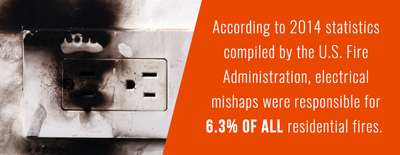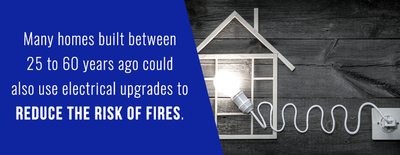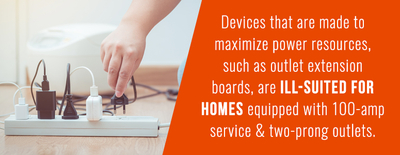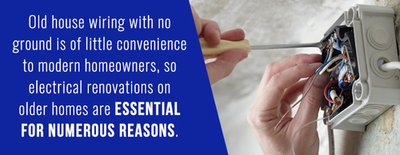Reasons Your Older Home May Need an Electrical Renovation

In the average household, electricity is often taken for granted. In older homes, this can be problematic for numerous reasons. A property with an outdated home amp capacity could be vulnerable to common electrical problems like safety issues, fire hazards, power surges and insufficient power. Therefore, the cost to upgrade your house’s electrical system and all that entails — home surge protector installation, 2-prong outlet code and safety upgrades — could be a wise investment, especially if you live in a century-old property.
Table of Contents
Safety
In older homes, outlets typically consist of only two prongs. For modern appliances, this can be problematic for two reasons. For starters, a two-prong outlet lacks the ability to provide enough power to the common household fixtures and appliances of today. Consequently, fuses are prone to blow when all the outlets in a two-prong older home are being used at the same time with energy-intensive equipment like refrigerators, ovens, hair dryers and even Christmas lights.
Another problem with two-prong outlets is that they leave appliances more vulnerable to power surges. This is due to a lack of access to the ground wire in a home’s circuitry. In modern homes with three-prong outlets, the third prong connects each device to the ground wire — also known as the equipment grounding conductor (EGC) –which is in place to protect the home from power surges.
Older homes are further complicated by knob-and-tube wiring, which was the standard form of residential wiring between the late 1800s and 1930. With this wiring, knobs were attached to joists inside the dark spaces of a home where the circuitry would run. The knobs were meant to keep the wires from touching the joists. In places where the wire had to pass through the joists, tubes were used to keep the wires from touching the wood. Over time, however, this form of wiring has proven unstable and potentially dangerous.
The most troubling possibility of worn-out wiring is electrified wood, which can occur when the wires and joists make contact. While a house with such wiring might not face imminent risk, older homes should be checked for such wiring and given a full — or at least partial — upgrade. The more electricity that an older household consumes, the higher the risk factor of outdated knob-and-tube wiring.
For the average homeowner, it’s difficult to tell which type of wiring exists within the walls of a house of any age. You can find this out, however, when you hire an electrical renovation specialist to upgrade the two-prong outlets in your home to three-prong outlets. In any case, it’s time to call an electrician if you notice any of the following danger signs:
- Loose switches. If a device activates, then momentarily flickers off before reactivating, it’s a sign that the wiring within the wall has come loose.
- Warm outlets. Unless you’re dealing with a dimmer switch, which is made to handle resistance, an outlet should never feel warm to the touch.
- Loose plugs. If a plug feels loose inside an outlet, it’s a potential fire hazard.
- Rusty panels. If corrosion is apparent on the metal panels of the electrical circuitry, there could be a water leak within the walls.
The cost of replacing electrical wiring in an old house is well worth the improved safety that such a service can offer.

Fire Risk
According to 2014 statistics compiled by the U.S. Fire Administration, electrical mishaps were responsible for 6.3 percent of all residential fires. This accounts for roughly 24,000 fires throughout the U.S., 11 percent of which resulted in at least one fatality. Common causes of residential fires, particularly in older homes, include the following:
- Faulty outlets. Houses that don’t have three-prong outlets generally lack the capacity for modern-day electrical appliances. When outlets are overloaded, hazardous sparks from blown fuses are among the risks. Faulty wiring within the receptacles and switches can also put your house at risk for fire-causing sparks.
- Outdated wiring. If the wires behind your walls are weak, degraded or simply not up to current building codes, your house could be at risk of catching fire. In the knob-and-tube wiring of Victorian-era homes, the wiring can sometimes come loose from the knobs and electrify the wood. Likewise, the aluminum wiring of homes built during the late 1960s and early ’70s has also proven over time to be weak and hazardous.
- Insufficient power. Victorian homes were built in an era when no one foresaw the development of modern-day household items like computers, stereos, big-screen televisions or even hair dryers. Consequently, homes that predate these technological developments are generally ill-equipped for the demands of such fixtures and appliances. As such, an older home’s electrical supply can become overwhelmed when such items are powered simultaneously, and this can lead to blown fuses.
While it’s necessary to increase home amp capacity in houses built during the early 20th century, many homes built between 25 and 60 years ago could also use electrical upgrades to reduce the risk of fires. This holds especially true in houses where the following items are put to regular use:
- Extension cords. An extension cord is meant to be used temporarily for very specific applications that don’t factor into your daily routine. Therefore, if there aren’t enough outlets to power your household appliances or fixtures, extension cords aren’t the solution — it’s time to have more outlets installed in your home.
- Light fixtures. If you’ve found it necessary to set up more than one or two plug-in light fixtures in your living room or bedroom, chances are your rooms could use more grounded lighting. In an older home, the abundance of light fixtures could possibly strain the overall amp capacity. More dangerously, light fixtures — especially older ones — could fray along the cords and set off sparks along floors and carpeting.
- Space heaters. If your heating system lacks the power to handle the challenges of cold winters, portable space heaters are not the answer. The heating coils in these units can ignite any flammable material within close range. Consequently, space heaters are a common cause of residential fires, particularly in bedrooms, where such units are often placed inches away from quilts and bedding.
If your house lacks enough outlets to power each device, or the home amp capacity is insufficient, it’s time to add new outlets, boost the capacity and upgrade two-prong outlets to three prongs.

More Power
Homes built a century ago were designed to accommodate the household technologies of the day. As such, the outlets in the typical living room of an Edwardian home were made to handle a pair of lamps and little else. Consequently, if a home built during that era has not undergone an electric renovation over the years, it’s probably incapable of powering today’s high-energy household fixtures.
Surviving homes from that time period will usually have a service capacity of 100 amps, 125 amps or 150 amps. In some of today’s smaller homes, only the last of those capacities might suffice. Otherwise, contemporary homeowners need a 200-amp electrical service to power the household necessities of the modern day.
The electrical upgrade to 200 amp service cost pays itself back with the following benefits:
- Greater capacity. Every time you bring home a new component for your computer or entertainment system, your house consumes more energy from there on out. Home amp panel upgrades allow people to run dozens of devices simultaneously with no fear of overloading a power source.
- Adaptability. As technologies change, a house could require more energy in the decades ahead. Just like homeowners in the 1920s could have never foreseen the arrival of energy-intensive devices like microwave ovens and personal computers, there could be a number of product innovations in the coming years that might radically change people’s daily lives. As such, a house should be equipped with the electrical capacity to power such products.
As things currently stand, most households need an array of devices to stay connected and comfortable all year round. While some of these fixtures have existed for half a century, none of them were imaginable when homes were built for 100-amp service:
- Electric ranges. As one of the most energy-intensive appliances, the typical electric range draws 50 amps on average. In the days of gas–powered ranges, no one imagined that the kitchen’s primary cooking fixture would one day consume half the power in a 100-amp home.
- Air conditioners. A central air conditioner will consume approximately 30 amps, while a window A/C unit will consume about 20 amps.
- Heating devices. Most devices used for heating purposes, such as a curling iron or blow dryer, will consume between 15 and 18 amps.
For obvious reasons, devices that are made to maximize power resources — such as outlet extension boards — are ill-suited for homes equipped with 100-amp service and two-prong outlets.

Protection From Surges
One of the most damaging yet elusive and misunderstood threats to the electrical components in a given household is the power surge, which could result from any of the following occurrences:
- Lightning. Though the most obvious and feared of power surge causes, lightning is far from the most common. While it’s true that lightning will send tens of thousands of volts into any affected circuitry, the bolt must hit within a mile for a given house to bear the impact.
- Downed power lines. This is one of the more common causes, though downed power lines are often caused by lightning. When power lines get struck down, connected households will often face blackouts. Once that ordeal has ended, previously smooth-running home devices might not work as before, if at all.
- Supply issues. In certain instances, power usage can momentarily change at a nearby factory, and this can have negative effects on homes with power lines that are connected to said facility.
While a surge might occur in only a fraction of a second, it can send untold numbers of volts into any electric device connected to an outlet in an affected property. As such, the following items can be instantly damaged or destroyed by a power surge:
- Computers. In most households, a personal computer is one of the most vulnerable yet valuable of possessions. Though it might store thousands of gigabytes of photos, documents, files and personal data, a computer could be fried in a split second by a power surge, the damage of which could affect any or all of the main components, such as the motherboard, monitor, hard drives, memory cards and peripherals.
- Entertainment systems. Even in homes of modest means, people will often sink small fortunes into high-tech entertainment systems, complete with DVD players and big-screen TVs. All of that money could be sunk in a second by a power surge, which could easily fry the monitor and disc player, as well as any gaming consoles or sound equipment hooked up to the system.
- Kitchen appliances. While lacking the artificial intelligence of computers and modern-day entertainment devices, good old kitchen appliances have some of the same vulnerabilities. Namely, the temperature controls of a refrigerator or stove could fail to work after taking a hit of undue voltage.
A 200,000–amp power surge will scorch 20-amp wiring instantaneously. As such, whole-house suppressors and home surge protectors can safeguard your ability to cook, be entertained and connect to the outside world from home.
At the bare minimum, a whole-house suppressor should be able to withstand a surge of at least 40,000 amps. That said, a suppressor won’t necessarily block the full brunt of a surge. In some instances, up to 15 percent of the voltage will still slip through, which is why you need the added security of a plug-in surge protector. Any unit that you select for this purpose should be equipped with an indicator light, which can be monitored to verify a suppressor or surge protector for its effectiveness.
Convenience
Old house wiring with no ground is of little convenience to modern homeowners, so electrical renovations on older homes are essential for numerous reasons, including the following:
- More outlets. When you upgrade two-prong outlets to three prongs, it gives you the opportunity to have additional outlets installed in your living room, bedrooms, work room and garage. That way, you can power more devices without overdrawing from any particular power source.
- Boosted resale value. Today’s homebuyers are less likely to purchase a home that lacks up-to-date wiring and power capacity. Therefore, the cost of replacing electrical wiring in your old house would be an essential step toward making the property attractive to future buyers, should you choose to sell.
- Home insurance. Many insurance providers will require that a home have electrical wiring that meets current building codes, so in order to secure a policy, you’ll likely need to have any wiring within your walls replaced beforehand.

Contact Us For Older Home Electrical Renovation Help
You might be wondering how to update the electrical wiring in your old house, but the answer is not to take things into your own hands. Contact Lippolis Electric for assistance with upgrading your home wiring system and avoid any electrical emergencies. At Lippolis Electric, we’re reputed for our prompt response time, highly trained technicians and competitive pricing to handle any electrical renovation project. Family-owned and operated, we serve homes throughout Westchester County.
Schedule service
Please note that your appointment is not set until confirmed by Lippolis Electric shortly after you've submitted the form.
| ‹ | › | |||||
| Sun | Mon | Tue | Wed | Thu | Fri | Sat |

